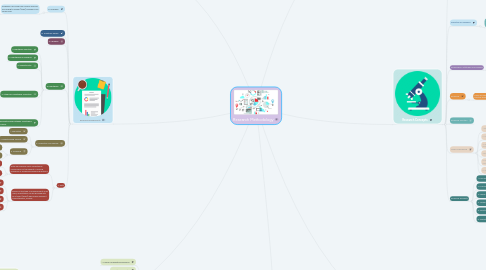
1. Research Components
1.1. A. Problems
1.1.1. Problems can come from various sources. According to Hadjar (1996), problems can come from:
1.1.1.1. 1.
1.1.1.2. 2.
1.1.1.3. 3.
1.1.1.4. 4.
1.1.1.5. 5.
1.2. B. Scientific Theory
1.3. C.Variables
1.4. D.Hypothesis
1.4.1. 1.Hypothesis Function
1.4.2. 2. Hypotheses in Research
1.4.3. 3. Characteristic
1.4.4. 4. Stages of Hypothesis Formation
1.4.4.1. a. Determination of the problem
1.4.4.2. b. Preliminary hypothesis
1.4.4.3. c. Collection of facts
1.4.4.4. d. Formulation hypothesis
1.4.4.5. e. Hypothesis testing
1.4.4.6. f. Application
1.4.5. 5. The Relationship between Hypothesis and Theory
1.5. E. Population and Sample
1.5.1. 1. Population
1.5.2. 2. Understanding Sample
1.5.3. 3. Sampling
1.5.3.1. a. Probability Sampling
1.5.3.2. b. Non Probability Sampling
1.6. F. Data
1.6.1. Data are empirical facts collected by researchers for the benefit of solving problems or answering research questions.
1.6.1.1. 1. Data by Source
1.6.1.2. 2. Data based on its characteristics
1.6.1.2.1. Based on the process or method of obtaining it, quantitative data can be grouped into two forms, namely as follows:
1.6.2. Based on the type of measurement scale used, quantitative can be grouped into four types (levels) which have different characteristics, namely:
1.6.2.1. 1. Nominal Data
1.6.2.2. 2. Ordinal Data
1.6.2.3. 3. Interval Data
1.6.2.4. 4. Ratio Data
2. Instrumens Research
2.1. A. The data collection technique
2.1.1. For humans, an instrument in the form of this test can be used to measure basic abilities and achievements or achievements. to measure basic abilities, among others, intelligence tests (IQ), interest tests, special aptitude tests.
2.1.1.1. 1. Collecting data through a questionnaire
2.1.1.2. 2. Data collection through the interview method
2.1.1.3. 3. Collection data through the Observation Method
2.2. B. Research Instruments
2.2.1. In this case, there are two kinds of evaluation tools that can be developed into research instruments, namely tests and non-tests (Narbuko, 2004).
2.2.1.1. 1. The Instruments Forms
2.2.1.2. 2. Form of Questionnaire
2.2.1.3. 3. Form of Interview Instruments
2.2.1.4. 4. Form of Observation Instruments
2.2.1.5. 5. The form for Rating Scale
2.2.1.6. 6. Forms of Documentation Instruments
2.3. C. Instrument Validity
2.3.1. Validity is one of the characteristics that marks a good learning outcome test.
2.3.1.1. 1. Types of Validity
2.3.1.2. 2. The validity of the question sets
2.3.1.3. 3. Factors that influence the validity
2.4. D. Reliability Instrument
2.5. E. Some mistakes in measuring
3. Research Design
3.1. A. Types of Research Design
3.1.1. The types of research design are
3.1.1.1. 1. Casual Comparative Research
3.1.1.2. 2. Riset Experimental
3.1.1.3. 3. Ethnographic research
3.1.1.4. 4. Historical Research
3.1.1.5. 5. Action Research
3.1.1.6. 6. Survey Research.
3.1.1.7. 7. Correlation Research
3.2. B. Types of Research Designs
3.2.1. 1. Cross Sectional Study
3.2.2. 2. A case control
3.2.3. 3. Cohort Study
3.2.4. 4. Experimental Research
3.2.5. 5. Quasi Experimental
4. Data Analysis Design
4.1. B. Qualitative Research
4.1.1. 1. Definiton of Qualitative Data Analysis
4.1.2. 2. Qualitative Data Analysis Methods.
4.1.2.1. The analysis process is as follows:
4.1.2.1.1. a. Data reduction
4.1.2.1.2. b. Presentation of Data
4.1.2.1.3. c. Conclusion of verivication
4.1.3. 3. Types of Qualitative Data Analysis
4.2. A.Quantitative Reseach
4.2.1. 1. Definition of Data Analysis
4.2.2. 2. Purpose of Quantitative Data Analysis
4.2.3. 3. Quantitative Research Data Analysis methods.
4.2.4. 4. Principles of data Analysis
4.2.5. 5. Quantitative Research Data Analysis Process.
4.2.5.1. There are two kinds of statistics used to analyze the data in the study, namely descriptive statistics and inferential statistics. Inferential statistics include:
4.2.5.1.1. a. Descriptive Statistics
4.2.5.1.2. b. Inferential Statistics
4.2.6. 6. Data Analysis Steps
4.2.6.1. Broadly speaking, the analysis work includes 3 steps, namely:
4.2.7. 7. Types of Quantitative Data Analysis
5. Research Concepts
5.1. Truth
5.1.1. 1. Non-Scientific Approach
5.1.2. 2. Scientific Approach (modern)
5.2. Definition of Research
5.2.1. From the understanding of research put forward by experts, among others, are as follows:
5.2.1.1. 1.Parson
5.2.1.2. 2. John
5.2.1.3. 3. Woody
5.2.1.4. 4.Donald Ary
5.2.1.5. 5. Hill Way
5.2.1.6. 6. Winarno Surachmand
5.2.1.7. 7. SOetrisno Hadi
5.2.1.8. 8. Cooper & Emory
5.2.1.9. 9. Suparmoko
5.3. Researcher"s Attitudes and Thinking
5.3.1. A researcher must have a distinctive and strong attitude in mastering the procedures and principles in research. The attitudes that a researcher must develop are as follows.
5.3.1.1. 1. The Attitudes of an Researcher
5.3.1.2. 2.The way of thinking expected of a researcher is as follows.
5.4. Research
5.4.1. There are various research objectives, seen fromthe effort to limit this, namely:
5.4.1.1. 1. Exploration
5.4.1.2. 2. Description
5.4.1.3. 3.Prediciton
5.4.1.4. 4.Explanation
5.4.1.5. 5. Action
5.5. Research Function
5.6. Types of Research
5.6.1. 1.Research Reviewed an Objectives
5.6.2. 2. Research Reviewed from Approach
5.6.3. 3. Research viewed from the field of science
5.6.4. 4.Research in terms of place
5.6.5. 5. Research in terms of the presence of the variables
5.6.6. 6. Quantitative and Qualitative
5.7. Research Elements
5.7.1. 1. concept
5.7.2. 2. Proposition
5.7.3. 3. Theory
5.7.4. 4. Variable
5.7.5. 5. Hypothesis
5.7.6. 6. Operational Definition
6. Quantitative and Qualitative
6.1. A. Quantitative Research
6.1.1. Some quantitative research methods that are used quite often are surveys and experiments.
6.1.1.1. 1. Survey Method
6.1.1.2. 2. Experimental
6.2. B Qualitative Research
6.3. C. Quantitative and Qualitatve
6.3.1. Hamidi explained that there are at least 12 differences in quantitative and qualitative approaches as follows:
6.3.1.1. 1.
6.3.1.2. 2.
6.3.1.3. 3.
6.3.1.4. 4.
6.3.1.5. 5.
6.3.1.6. 6.
6.3.1.7. 7.
6.3.1.8. 8.
6.3.1.9. 9.
6.3.1.10. 10.
6.3.1.11. 11.
6.3.1.12. 12.
6.3.2. Meanwhile, according to Sugiyono (2012) the difference between quantitative research methods and research methods includes three things, namely differences about axioms, research processes, and research characteristics.
6.3.2.1. 1. The Difference Axioms
6.3.2.2. 2.Relations between researchers and those studied
6.3.2.3. 3. Relationship between variables
6.3.2.4. 4.The possibility of generalization
6.3.2.5. 5.The Role of Value
